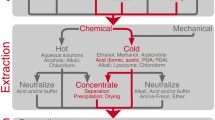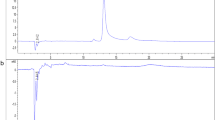Abstract
Intracellular nucleotides of Salmonella typhimurium were separated and quantified by high performance liquid chromatography (HPLC). Wild type and specially constructed strains of S. typhimurium, in which uridine and cytidine nucleotides could be manipulated independently, were used in this study. By varying growth conditions it was possible to create different concentrations of uridine and cytidine nucleotides in the cell. The specific activity of ATCase was determined for each condition. Generally, a direct correlation was found: at high nucleotide (UTP) concentrations, maximal repression of ATCase was usually seen; at low nucleotide (UTP) concentrations ATCase was derepressed. However, it was the ratio of the concentrations of UTP-to-CTP rather than either the concentration of UTP or CTP alone that best determined the extent of ATCase expression. This applied to all conditions in the present work as well as to all conditions in work hitherto reported by others. The ratio of UTP/CTP is proposed as a key regulatory parameter for pyr enzyme expression.
Similar content being viewed by others
References
BellinoF (1973) Continuous synthesis of partially derepressed aspartate transcarbamylase during the division cycle of Escherichia coli B/r. J Mol Biol 74: 223–238
BonekampF, ClemmesenK, KarlstromO, JensenKF (1984) Mechanism of UTP-modulated attenuation at the pyrE gene of Escherichia coli: an example of operon polarity control through the coupling of translation to transcription. EMBO J 3: 2857–2861
ChenSC, BrownPR, RosieDM (1977) Extraction procedures for use prior to HPLC nucleotide analysis using microparticle chemically bonded packings. J Chromatogr Sci 15: 218–221
DavisBD, MingioliES (1950) Mutants of Escherichia coli requiring methionine or vitamin B12. J Bacteriol 60: 17–28
DuttaPK, O'DonovanGA (1987) Separation and quantitation of bacterial ribonucleoside triphosphates extracted with trifluoroacetic acid, by anion exchange high-performance liquid chromatography. J Chromatogr 385: 119–124
GerhartJC, PardeeAB (1962) The enzymology of control by feedback inhibition. J Biol Chem 237: 891–896
GintherCL, IngrahamJL (1974) Cold-sensitive mutant of Salmonella typhimurium defective in nucleoside diphosphokinase. J Bacteriol 118: 1020–1026
JensenKF (1979) Apparent involvement of purines in the control of expression of Salmonella typhimurium pyr genes: Analysis of a leaky guaB mutant resistant to pyrimidine analogs. J Bacteriol 138: 731–738
JensenKF, NeuhardJ, SchackL (1982) RNA polymerase involvement in the regulation of expression of Salmonella typhimurium pyr genes. Isolation and characterization of a fluorouracil-resistant mutant with high constitutive expression of the pyrB and pyrE genes due to a mutation in rpoBC. The EMBO J 1: 69–74
JensenKF, FastR, KarlstromO, LarsenJN (1986) Association of RNA polymerase having increased Km for ATP and UTP with hyperexpression of the pyrB and pyrE genes of Salmonella typhimurium. J Bacteriol 166: 857–865
JustesenJ, NeuhardJ (1975) pyrR identical to pyrH in Salmonella typhimurium: control of expression of the pyr genes. J Bacteriol 123: 851–854
KaplanR, CohenL, YagilE (1975) Acid-soluble degradation products of ribonucleic acid in Escherichia coli and the role of nucleosidases in their catabolism. J Bacteriol 124: 1159–1164
KellnRA, O'DonovanGA (1976) Isolation and partial characterization of an argR mutant of Salmonella typhimurium. J Bacteriol 128: 528–535
KellnRA, KinahanJJ, FoltermannKF, O'DonovanGA (1975) The pyrimidine biosynthetic enzymes of Salmonella typhimurium repressed specifically by growth in the presence of cytidine. J Bacteriol 124: 764–774
LevinHL, SchachmanHK (1985) Regulation of aspartate transcarbamoylase synthesis in Escherichia coli: Analysis of deletion mutations in the promoter region of the pyrBI operon. Proc Natl Acad Sci USA 82: 4643–4647
LevitskiA, KoshlandDE (1969) Negative cooperativity in regulatory enzymes. Proc Natl Acad Sci USA 62: 1121–1128
LowryOH, RosebroughNJ, FarrAL, RandallRJ (1951) Protein measurement with the Folin phenol reagent. J Biol Chem 193: 265–275
MaasWK (1961) Studies on repression of arginine biosynthesis in Escherichia coli. Cold Spring Harbor Symp Quant Biol 26: 183–191
MichaelsG, KellnRA, NargangFE (1987) Cloning, nucleotide sequence and expression of the pyrBI operon of Salmonella typhimurium LT2. Eur J Biochem 166: 55–61
Munch-PetersenA, MygindB (1983) Transport of nucleic acid precursors. In: Munch-PetersenA (ed) Metabolism of nucleotides, nucleosides and nucleobases in microorganisms. Academic Press, London, pp 259–305
NavreM, SchachmanHK (1983) Synthesis of aspartate transcarbamoylase in Escherichia coli: transcriptional regulation of the pyrB-pyrI operon. Proc Natl Acad Sci USA 80: 1207–1211
NeuhardJ (1968) Pyrimidine nucleotide metabolism and pathways of thymidine triphosphate biosynthesis in Salmonella typhimurium. J Bacteriol 96: 1519–1527
NeuhardJ (1983) Utilization of preformed pyrimidine bases and nucleosides. In: Munch-PetersenA (ed) Metabolism of nucleotides, nucleosides and nucleobases in microorganisms. Academic Press, London, pp 95–148
NeuhardJ, IngrahamJL (1968) Mutants of Salmonella typhimurium requiring cytidine for growth. J Bacteriol 95: 2431–2433
NeuhardJ, StauningE, KellnRA (1985) Cloning and characterization of the pyrE gene and of pyrE:: Mud1 (Apr lac) fusions from Salmonella typhimurium. Eur J Biochem 146: 597–603
NierlichDP (1978) Regulation of bacterial growth, RNA, and protein synthesis. Ann Rev Microbiol 32: 393–432
PrescottLM, JonesME (1969) Modified methods for the determination of carbamyl aspartate. Anal Biochem 32: 408–419
RolandKL, PowellFE, TurnboughCLJr (1985) Role of translation and attenuation in the control of pyrBI operon expression in Escherichia coli K-12. J Bacteriol 163: 991–999
RoofWD, FoltermannKF, WildJR (1982) The organization and regulation of the pyrBI operon in E. coli includes a rho-independent attenuator sequence. Mol Gen Genet 187: 391–400
SchwartzM, NeuhardJ (1975) Control of expression of the pyr genes in Salmonella typhimurium: effects of variations in uridine and cytidine nucleotide pools. J Bacteriol 121: 814–822
SmithJM, KellnRA, O'DonovanGA (1980) Repression and derepression of the enzymes of the pyrimidine biosynthetic pathway in Salmonella typhimurium. J Gen Microbiol 121: 27–38
TurnboughCLJr (1983) Regulation of Escherichia coli aspartate transcarbamylase synthesis by guanosine tetraphosphate and pyrimidine ribonucleoside triphosphates. J Bacteriol 153: 998–1007
TurnboughCLJr, HicksKL, DonahueJP (1983) Attenuation control of pyrBI operon expression in Escherichia coli K-12. Proc Natl Acad Sci USA 80: 368–372
Valentin-HansenP (1978) Uridine-cytidine kinase from Escherichia coli. Meth Enzymol 51: 308–314
Author information
Authors and Affiliations
Additional information
Dedicated to Professor John Ingraham in appreciation for his guidance during my graduate work and in admiration for his confidence and eternal optimism
Rights and permissions
About this article
Cite this article
O'Donovan, G.A., Herlick, S., Beck, D.E. et al. UTP/CTP ratio, an important regulatory parameter for ATCase expression. Arch. Microbiol. 153, 19–25 (1989). https://doi.org/10.1007/BF00277535
Received:
Accepted:
Issue Date:
DOI: https://doi.org/10.1007/BF00277535




